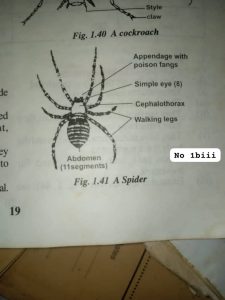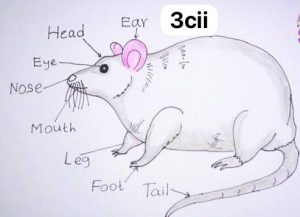Neco 2023 Biology practical questions and answers

(2ai)
Specimen E: Spirogyra filaments
Specimen F: Mucor
Specimen G: A week old groundnut seedling
Specimen H: A week old maize seedling
Specimen I: Microscope
(2aii)
E: Aquatic habitat
F: Damp and decaying organic matter
(2aiii)
E: Autotroph
F: Saprophytes
(2aiv)
They produce their own food through photosynthesis.
(2bi)
Specimen E:
(PICK ANY THREE)
(i) Green coloration.
(ii) Long and filamentous structure.
(iii) Transparent cellulose cell wall
(iv) Spiral-shaped green chloroplasts
Specimen F:
(i) Presence of spores.
(ii) Thread-like structure.
(iii) Elongated spore-containing structure.
(2bii)
Colour: Green
Role: For capturing sunlight for photosynthesis and energy production
(2ci)
(i) Class of G: Angiospermae.
(ii) Class of H: Angiospermae
(2cii)
(i) Specimen G: Hypogeal Germination
(ii) Specimen H: Epigeal Germination
(2ciii)
(i) Specimen G: Reticulate venation
(ii) Specimen H: Parallel Venation
(3ai)
K – Pigeon
L – Agama lizard
M – Rat
N – Tilapia
(3aii)
(i) Agama lizards have a strong elongated jaw with sharp teeth adapted for capturing and consuming their prey.
(ii) They have eyes positioned on the sides of their head providing them with a wide field of vision to detect predators and prey.
(iii) Agama lizards have ear openings on the sides of their head allowing them to detect sounds and vibrations in their environment.
(iv) Some species of Agama lizards have a prominent dorsal crest that runs along the length of their head and neck which may serve as a display feature during courtship or territorial disputes.
(3bi)
(PICK ANY FIVE)
(i) Pigeons have a sleek and aerodynamic body shape that reduces air resistance and allows for efficient flight.
(ii) They possess strong pectoral muscles that enable rapid and sustained wing beat for flight.
(iii) Pigeons have lightweight and hollow bones that reduce their overall body weight making it easier for them to fly.
(iv) Their respiratory system including air sacs allows for a continuous flow of oxygen during flight providing them with the necessary energy.
(v) Pigeons have exceptional eyesight enabling them to navigate and find food sources while in flight.
(vi) Pigeons have a remarkable ability to return to a specific location from far distances which is believed to be due to their exceptional navigational skills.
(vii) Pigeons have specialized feathers that provide control and stability during flight as well as insulation and protection from the elements.
(3bii)
TABULAR FORM
-SPECIMEN K-
(PICK ANY TWO)
(i) Wings
(ii) Beak
(iii) Feathers
(iv) Legs and feet
-SPECIMEN L-
(PICK ANY TWO)
(i) Limbs
(ii) Scales
(iii) Tail
(iv) Jaws and Teeth
(3ci)
(PICK ANY TWO)
(i) Beak and Jaw Structure
(ii) Body Shape and Posture
(iii) Wing and Limb Adaptations
(iv) Coloration and Camouflage
(v) Visual and Auditory Perception
(3cii)
Check the diagram belo 
Admin solving and typing……..


